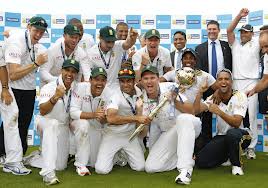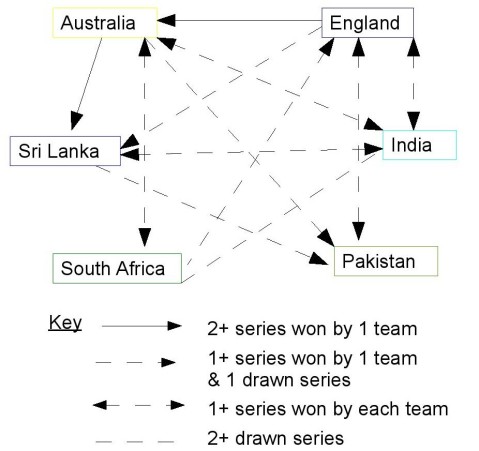Close match-ups and one-sided matches

Australia’s cricketing decline at the end of the last decade opened up Test cricket to one its most evenly competitive eras. A pack of well-matched teams have traded blows and consistently defeated a second group made up of weaker teams. This period may be about to close as South Africa are now pushing ahead of the pack.
The group of well-matched teams numbers six: Australia, England, India and South Africa – all of whom have maintained ICC rankings of above 100 since 2008 – Sri Lanka and Pakistan – the former in decline, the latter ascendant.
This post considers the contests between these well-matched teams and assesses the sort of match outcomes produced. The aim is to test whether this era of relatively evenly matched teams has led to competitive test cricket.
The six teams provide a possible 15 bilateral contests. 12 of these match-ups had two or more series (including two test contests, aka two-offs). Two had just one series (South Africa v Pakistan and SA v Sri Lanka) and no test matches were played between Pakistan and India.
The chart below shows the outcomes of the 12 contests with two or more series. Five of the 12 contests saw each side winning a series. Only two of the contests were one-sided – one team winning all series. At this level of analysis it seems to have been an era of competitive, close match-ups. South Africa provide something of an exception, losing a series in only one of the contests. All the other teams lost series against three opponents.
The six Test teams contested 33 series in this period. The chart below shows the distribution of series results. Two-thirds were closely contested, using the indicator of a drawn series or a one test margin. Almost half saw both sides winning matches. But there were some one-sided affairs.
This post ends with a match-level analysis of how close the contests were. To do this I have introduced the concept of the ‘major’ victory, where the margin of victory is significant. I settled on two measures:
- a victory by 6 wickets or more (using median partnerships, 75% of a team’s runs in two completed innings would be scored with the loss of 14 wickets)
- a victory margin in runs equivalent to 25% or more of the runs scored by the winning team in the match.
In total, 100 tests were played in these 33 series. 25% were draws; 49% were home wins; 26% away wins. The incidence of major victories, home and away is shown below. Playing at home or away, 73% of victories were by margins that I have considered to be ‘major’.
Included in the major victories are three where the winning team scored 40% more runs than its opponent; 23 innings victories and 9 victories by nine or ten wickets.
(I have not attempted to assess teams’ relative positions in drawn matches, relying instead on the notion that those games are indeterminate. I acknowledge that a detailed review of drawn games would show some that one team was odds-on to win but for weather interruption.)
The impression of how closely contested these fixtures were shifts as the analysis moves from the high level analysis of series results down to individual matches. At the higher level, there were few one-sided contests as most involved both teams winning a series or one team victorious in a series but drawing the return series. Looking at individual series results two-thirds had teams drawing or separated by a single result. But at the individual match level, almost three-quarters of victories were by significant margins.
This is the paradox I call close match-ups and one-sided matches. In a future post, I will look in more detail at the matches to see how two even teams end up with uneven results.
3 responses to “Close match-ups and one-sided matches”
Trackbacks / Pingbacks
- - May 15, 2013




I have a possible explanation for the point about even teams ending up with uneven results. Generally in tests that end in results one team will enjoy the advantage throughout, or at least from when it is possible to measure advantage. Once a team is in a position where their only possible successful result is a draw, they will play much more defensively, and as such will score more slowly, and have the tempo of their bowling innings forced on them by the advantaged team. A winning test team will naturally press their advantage within a particular match, so once you are losing it can be very difficult to reverse the trend.
One way of measuring this perhaps would be to assess the win percentage of teams who lead by more than 100 after the first innings. Wonder if statsguru can handle that.
Thanks very much for the comment. Your explanation seems sound and is one of a few I’ll test when I do a detailed review of particular matches.